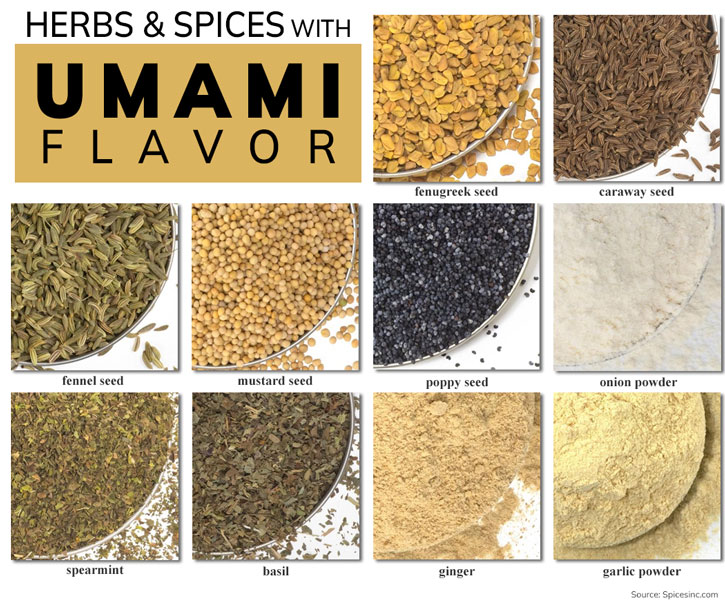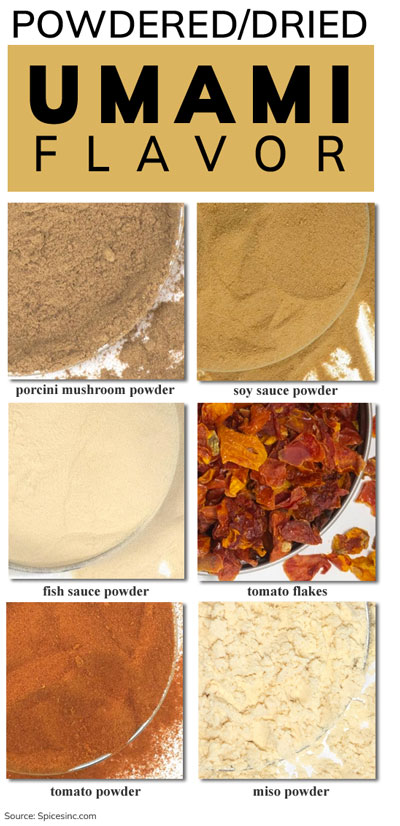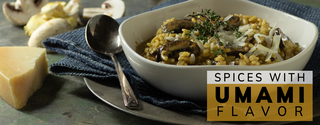Spices With Umami Flavor

What is Umami
The Japanese word umami has been translated as “pleasant savory taste” or “the essence of deliciousness”. It describes the soul-satisfying depth of flavor in meats and is also found in foods like mushrooms, aged cheeses, and soy sauce.
For years umami was the “I can’t quite put my finger on this” savory quality that we could recognize but didn’t know how to describe. It became a concept in 1908 when Kikunae Ikeda, a chemistry professor at Tokyo’s Imperial University, analyzed the flavor components in a broth made from kombu seaweed. Ikeda found that kombu broth contains glutamates, which create a flavor distinct from the sweet, sour, salty, and bitter flavors detected by the tongue. In the 1980s, umami was officially declared to be the fifth taste. In 2002, scientists discovered that the human tongue is home to umami-specific taste buds, meaning that umami is not a Japanese concept but a part of the human experience.
Spices with Umami Flavors
Many want to know if umami is a specific spice or an herb. Umami is not a distinct spice or herb but an essential flavor characteristic of some spices and herbs that contain a high concentration of glutamic acid.
The top spices and herbs that produce umami essence include:
Mustard Seed
Poppy Seed
Fenugreek Seed
Caraway Seed
Fennel Seed
Spearmint
Garlic
Onion
Basil
Ginger
We experience umami thanks to the presence of glutamate, inosinate, and guanylate, chemical compounds that naturally occur in plants and meat. Glutamate, or glutamic acid, is an amino acid. It is the most common compound we encounter in our food, and it has little flavor when it is embedded within an intact protein chain. When the amino acid chain breaks down due to age or external forces, like a cooking fire, the glutamates are “free” and form savory flavors. Free glutamates, when eaten, bind to receptors across the tongue and create the mouthwatering sense of umami that we crave.
Glutamates are often associated negatively with monosodium glutamate, or MSG, the sodium salt derived from glutamic acid. While older research indicated that MSG created a harmful metabolic syndrome, current scientific studies have determined that the older research has significant flaws. MSG is now Generally Regarded As Safe (GRAS) by the US Food and Drug Administration, though some may have sensitivities to it as a flavor enhancer.
Umami Ingredients
People have been pursuing ingredients that deliver an umami flavor profile since the dawn of recorded history. For example, fish sauce, in one form or another, has been in production since at least the 5th century BC and perhaps as early as the 7th or 8th century BC. Foods that have been fermented, like fish sauce or aged, like Parmesan, bleu cheese, and sun-dried tomatoes, produce the glutamates we crave during their processing.
 The top food products that deliver rich umami essence include:
The top food products that deliver rich umami essence include:
Porcini Mushroom Powder
Tamari Soy Sauce Powder
Fish Sauce Powder
Tomato Flakes
Tomato Powder
Organic Red Miso Powder
Organic White Miso Powder
Umami-rich foods and spices should be paired with flavors that offer balance to their inherent depth. The other four basic tastes—salty, sour, sweet, or bitter—can be paired with umami to create a complex and appealing dish. We often do this without thinking; umami Caraway Seeds pair well with sweet apples and bitter cabbage. Fish Sauce Powder shines with the addition of tart lime or lemon or in a sweet and sour marinade.
Try tossing bitter Brussels sprouts with Tamari Soy Sauce Powder and roasting, which will also coax out any sweetness locked deep inside. Tomato Flakes bring natural depth and enhancement to bitter greens like arugula. Spices like green cardamom and herbs like bay leaves have bold and bright profiles and pair wonderfully with a wide range of umami foods. You can experiment by pairing sweet paprika, cumin, allspice, tamarind, parsley, cocoa, or cinnamon with umami-rich foods. These spices bring a certain quality—earthiness, sweetness, heat, woodsiness, and so on—that play creatively with glutamates and help create a round, full-bodied appeal in various dishes.
Umami can be tricky to describe and identify because its nature is deep and subtle, and the flavor it presents depends on the item that’s delivering umami. Even though umami is not one specific product, its flavor is present in umami-friendly spices and herbs, many of which are our most flavorful aromatics that are used for their umami properties in an enormous array of dishes. It can also be found in a wide range of umami-rich ingredients, like sun-dried tomatoes and porcini mushrooms. Sun-dried tomatoes do not taste like porcini mushrooms. Still, they impart the savory sensation that spreads across the tongue, lingers after other flavors have faded, and brings mouthwatering deliciousness to your plate.

